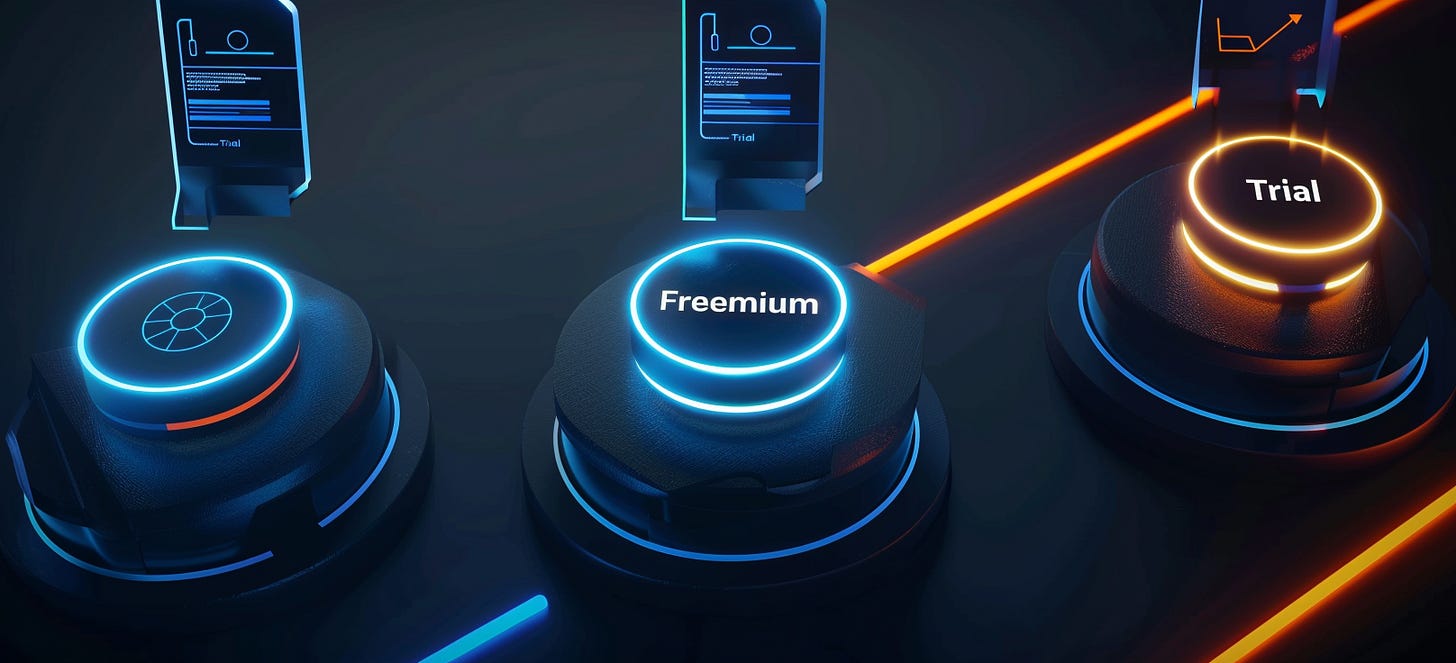Redefining B2B SaaS Growth with Product-Led Sales
The Convergence of Product-Led Growth and Sales-Led Growth
In today's rapidly evolving B2B SaaS business model, the selling paradigm has significantly transformed, with product-led sales taking center stage. The shift from primarily Sales-Led Growth (SLG) to an increased emphasis on Product-Led Growth (PLG) while keeping the best of both worlds represents a fundamental change in demand generation strategy. The most effective approach, as demonstrated by successful startups that scaled rapidly beyond $50M ARR, is a hybrid model that synergistically combines SLG's and PLG's strengths to create a product-led sales motion.
In this blog post, I share professional insights I gained from the development of PLG strategies that co-exist with SLG at prominent organizations such as Turnitin, Bitrise, and insightsoftware. I examine the key benefits and challenges of implementing product-led sales, address the necessary cultural adjustments, and highlight the importance of collaborative efforts across sales, marketing, product, and engineering teams. This discussion also emphasizes how PLG can complement and enhance SLG strategies, thereby creating a more comprehensive land and expanding growth motion in the competitive landscape of B2B SaaS. This post aims to provide a thorough understanding of this integrated approach, which merges PLG and SLG into product-led sales to drive business success.
Why is PLG so hard?
A successful implementation of PLG presents a series of significant challenges. At the heart of these challenges is the necessity for robust, multi-disciplinary collaboration. Departments such as Sales, Marketing, Product, Engineering, Design, and Research must not only align their strategies and operations but also work cohesively towards a common goal of building a compelling user journey where the product demonstrates value through the adoption of core functionality, eventually enabling the user to reach the stage of activation and purchase. Suppose not all of these departments can participate or may not even exist in your organization. In that case, roles will have to be assigned to existing team members who are not experts in those domains, hindering progress as they need to become more familiar and capable. This requirement for interdisciplinary integration sets a high bar for a successful PLG implementation, not to mention the investment required in time and therefore cost to make PLG work when other priorities are in daily demand.
Once the interdisciplinary team is assembled and committed, the next hurdle in the creation of PLG and integration with SLG is the cultural shift that it requires. Traditional SLG models typically focus on sales teams driving customer acquisition and revenue, whereas PLG demands a product-centric approach where the product does the initial selling. This shift requires a fundamental change in organizational mindset and operational dynamics. It's not uncommon that sales leadership views PLG as either competitive (especially when compensation models are not set up right) or a source of leads that should be nurtured by sales reps before users have a chance to adopt the product and recognize value. Overcoming this cultural barrier involves reorienting the entire organization's focus towards product-led strategies and ensuring that all teams understand and embrace the value of this approach.
The cultural shift for PLG also needs to take place in marketing. Lead generation will now include a significant, if not majority, effort to get the user to try the product. Growth loops, if established effectively, will empower users to be advocates and spread the product to their colleagues and friends. These marketing activities complement or enhance the virality of the product and are squarely targeted at the end practitioner, who frequently is not the target audience for SLG. The desire to chase a larger deal size with direct selling means the audience is further up the chain with bigger projects and larger scope, not a user or team that may start small and only spend thousands if not hundreds of dollars per year.
In a PLG motion, the product is designed to sell itself, requiring product teams to be deeply attuned to user needs and experiences.
Another significant challenge is the need for more alignment of goals between departments. In a PLG motion, the product is designed to sell itself, requiring product teams to be deeply attuned to user needs and experiences. Conversely, sales teams might prioritize immediate revenue generation with executive stakeholders. This divergence can lead to conflicting strategies and priorities, which occurred at all the companies I worked at. The most profound was the product team building a bottom-up user-based adoption model at the team level while sales were selling top-down and expected Enterprise-level functionality. There was a lot of frustration when this became apparent, and the sales team had to be reorganized, which impacted many good people. To address this, organizations must establish clear, unified objectives that reconcile product development aims with sales and marketing strategies, ensuring that all teams work towards a cohesive goal.
Resource allocation also poses a considerable challenge. PLG initiatives often require substantial investment in initial product development, user experience, and analytics capabilities to enable the product and supporting functions to be self-service. This can lead to reallocating resources that traditionally might have been directed toward feature development for sales-led deals.
When PLG becomes effective, sales and marketing should become more efficient and, therefore, lower cost, further sparking the debate about how much budget should be allocated to those departments. Organizations must balance their investments and ensure that resources are allocated efficiently to effectively support PLG and SLG strategies.
Furthermore, PLG implementation demands rapid exploratory iterations, such as A/B testing, to continuously refine the product based on user feedback and behavior. This approach requires a flexible and agile operational model, which can be a significant departure from the more linear and structured processes standard in many organizations. Companies need to foster a culture of agility and experimentation to adopt these iterative methods, where rapid testing and data-driven decision-making are the norms. Rapid testing can shock some organizations that operate in a more linear and methodical model. It's common to have multiple experiments and, therefore, changes to the product weekly. When organizations ship monthly or even quarterly to their customers, daily changes require a massive overhaul of processes.
To overcome these challenges, organizations should focus on fostering a culture that values cross-functional collaboration and continuous learning. Setting clear, aligned objectives across all departments, ensuring transparent communication, and developing a shared understanding of the PLG strategy are essential. Additionally, investing in training and development programs can help teams acquire the necessary skills and mindset to thrive in a PLG-focused environment. By addressing these challenges head-on, companies can unlock the full potential of PLG, driving growth and success in the competitive landscape of B2B SaaS.
Understanding the user's PLG journey
Understanding the nuances of a user's PLG journey is essential to optimizing the activities for the best conversion and creating growth loops that accelerate business results. The PLG journey is markedly distinct from the traditional Sales-Led Growth approach. For PLG, automation and analytics play a significant role, and knowing what to automate and optimize starts with understanding the user's journey.
In PLG, the user's journey centers around the user's registration, onboarding, and interaction with the product. The emphasis is on the product driving user engagement and conversion to a paying customer. Product engagement contrasts with the SLG model, where the sales team primarily guides potential customers through the sales funnel, often involving more complex negotiations and a broader set of stakeholders, like Enterprise procurement staff. The PLG journey is inherently scalable, as it leverages the product to engage and convert users, while SLG can provide a more personalized approach, especially for complex, high-value sales.
Documenting the user journey in a PLG model is crucial. It provides insights into how users interact with the product, what features they find valuable, and when they will likely convert. At Turnitin and Bitrise, user research, qualitative and quantitative, was the foundation for understanding the user journey. This documentation is instrumental in understanding users' pathway from initial engagement to realizing the product's value and where further optimization will improve the conversations to purchase. We used tools like Hotjar to create engagement heat maps and capture user behavior, while products like Amplitude revealed engagement with specific features.
A critical concept in the PLG journey is 'activation,' where user behaviors within the product indicate that the user has realized its value.
A critical concept in the PLG journey is 'activation,' where user behaviors within the product indicate that the user has realized its value. This realization is often observable through specific actions or engagement levels with the product, signaling that the user has experienced the product's key benefit. This point of value realization is crucial and typically marks the generation of a Product Qualified Lead (PQL). At Bitrise (a mobile DevOps tool), we found through analysis that a user building their mobile app more than six times successfully was likely to complete a purchase and, therefore, was an activation signal. The user overcame the hurdles in setting up the Bitrise product and debugging their mobile app successfully, and they were now able to build consistently.
A PQL moment is a great opportunity for the sales team to engage, as the user will be more receptive to a sales call once they have recognized the product's value. The data collected about the user and their engagement with the product so far signals an opportune time to start engaging with the user and provides the background to navigate the conversation. The transition from a PQL to a paying customer often involves guiding the user toward understanding the additional benefits and capabilities unlocked in the paid version of the product, as well as assisting with the required approvals and paperwork in larger organizations.
Both PLG and SLG journeys, as well as the handoff between the two, are essential for a comprehensive growth strategy with Enterprise transactions. PLG excels in creating initial interest and engagement at scale, allowing users to experience the product's value firsthand. In contrast, SLG is invaluable in navigating more complex sales cycles, especially those involving multiple decision-makers in higher-value deals. By understanding and documenting these journeys, companies can effectively tailor their strategies to leverage the strengths of both PLG and SLG, guiding users from initial product engagement to becoming long-term, valuable customers.
Instrumenting the user's PLG journey
Once the user's PLG journey is documented, the next step is to instrument the user journey to optimize the conversion to paid users. This process involves selecting key metrics along a typical user's journey, and visualizing them as a funnel, to identify and enhance underperforming stages.
In the initial stages of developing a user funnel, the selection of metrics is crucial, and keeping them to a small number to showcase success is best. The funnel metrics should include the user's journey to register and implement the product and the key steps leading to activation and purchase. Standard engagement metrics include product setup features. From my experience, that was course setup in Gradescope and connecting a repo in Bitrise. Further usage of crucial features after initial setup such as grading assignments in Gradescope or building a mobile app successfully in Bitrise, are essential signals leading to activation, and eventually conversion to paid. By closely monitoring these metrics, organizations can gain valuable insights into user behavior and readiness to buy, allowing them to make informed decisions for a more personalized and higher touch engagement.
In addition to choosing the right metrics, it is equally important to understand how these metrics can guide strategy adjustments and improvements. For instance, a low activation rate might suggest the need for a more intuitive user experience. The Designer can enhance the UX with guidance for new users utilizing built-in tutorials or out-of-the-box content to jump-start the adoption of the product and demonstrate value (at Bitrise, we offered a demo application that was ready to be built and deployed). Conversely, a high activation rate with a low paid conversion rate might indicate that while users find value with the free product, they need to perceive more value to upgrade to a paid version. Such insights are pivotal in fine-tuning the product experience, what is available for free, and the accompanying sales strategies to convert to paid.
A cohort-based funnel analysis provides a more nuanced view. By looking at users who started at the same time, you can understand how specific groups of users progress over time.
When analyzing these metrics, you can choose between using a snapshot or cohort-based approach to their funnels. A snapshot-based funnel provides a broad view, representing users at various stages of their journey irrespective of when they started. This approach offers a general overview but can sometimes mask specific user behaviors or patterns due to its aggregated nature. On the other hand, a cohort-based funnel analysis provides a more nuanced view. By looking at users who started at the same time, you can understand how specific groups of users progress over time. This method is particularly useful for identifying trends and patterns in user behavior, enabling companies to tailor their strategies to specific user segments. For example, a cohort analysis might reveal that users who engage with a particular feature in the first week are more likely to convert to a paid plan. Such insights are invaluable for targeted interventions, whether pop-up messages to guide the user, email messages with best practices, or sales stepping in to guide the user towards value realization (the "aha" moment).
Optimizing user engagement
Once you understand and instrument the user journey, the next step is optimizing user engagement for improved conversion rates. This process demands a meticulous focus on user experience design, personalized content, and leveraging customer feedback to create a compelling and tailored user journey.
The user journey starts with the website landing page that guides the user to register for the product, and the subsequent onboarding to start product usage. Each click should be carefully evaluated for drop-off. How many users abandoned their progress in the cohort? Superfluous steps or excessive form fields that detract users from signing up should be removed. At Bitrise, we eliminated all unnecessary friction. For example, we used to have an account confirmation step where an email was sent with a link to confirm the email address was valid. Who knows when the email would arrive and if spam blockers would prevent it from arriving at all. And the user had to open the email client, which is another friction point. At Bitrise, we realized that letting the user seamlessly continue would increase the number of users that tried the product, and we solved the email confirmation drop-off by postponing access to the most valuable action in the product, building the app until the user clicked the validation link. This was a simple solution to retain more users in the funnel because they got further into the product to try it out and get committed to using it.
In the realm of PLG, the product is the primary vehicle for user engagement. The emphasis is on designing an intuitive user experience that naturally guides the user to discover the product's value. At Turnitin, our Gradescope product had in-product guidance, including interactive tutorials and contextual tips that helped users understand and utilize key features effectively. At both Turnitin and Bitrise, we used off-product engagement strategies, like targeted email nurture sequences at key points in the user's journey. These sequences were carefully crafted to align with the user's stage in the product adoption process. They provided relevant information such as how-to help and tutorials, encouraging the user to deepen their engagement with the product.
Integrating personalized outreach and nurturing into PLG enhances the effectiveness of these efforts. Data and user insights also allow for the tailoring of messaging and interactions. For example, varying communication to resonate with different customer segments. In the case of Gradescope, what appeals to a Computer Science educator differs from that of an English Language educator, and the Marketing team would tailor the outreach to these specific audiences. Email can also be customized based on user behavior to provide bespoke product recommendations or support. For instance, a user frequently using a particular feature might receive content highlighting advanced functionalities or complementary features.
The power of personalized communication lies in its ability to create a more relatable and relevant user experience. When users feel that a product or service understands their unique needs and challenges, they are more likely to engage deeply and move towards conversion. This approach requires a robust data analytics framework to continuously gather and analyze user data, enabling real-time personalization and responsiveness to user needs.
Optimizing user engagement in PLG is about understanding the drop-off in engagement at every stage towards activation and purchase, and creating a user-centric experience that is both intuitive and personalized to drive the "aha" moment in the product. It involves a combination of thoughtful user experience design, data-driven personalization, and continuous engagement strategies. Focusing on these elements can significantly enhance user engagement, leading to improved conversion rates and sustained growth.
Product Qualified Leads
In a seamless integration of PLG and SLG, one of the critical transitions is the passing of leads, often categorized as Product Qualified Leads (PQLs). This process is integral for users deeply engaged with the product or larger Enterprise deals that require a nuanced, sales-driven approach.
The process of identifying PQLs is rooted in closely monitoring usage and adoption signals within the PLG model. The criteria for lead qualification must be clearly defined and agreed upon by both product and sales teams to ensure quality leads are passed to the sales team with the highest potential for conversion.. These signals might include a high level of engagement with the product, usage of certain key features, or reaching specific milestones that indicate a deepened reliance on and understanding of the product. In particular, if you establish strategic paywall boundaries in the product tied to key usage levers, such as Bitrise settling a limit on the number of builds that can be run monthly, the user will be incentivized to purchase the product or scale down their adoption if they are not ready to commit. Once the signals are identified, a PQL is generated and passed to the sales team for more personalized, direct engagement.
The handover process from PLG to SLG is a critical juncture and should be automated in the systems where sales teams work. Salesforce was the tool of choice everywhere I worked, and having the PQL's part of the standard selling process helped with prioritization and timely follow-up. Typically, the PQL includes comprehensive information about the lead's product usage and preferences.
Freemium and Trials
In the context of PLG, there are different models to try the product, such as Freemium, Trial, and Reverse-Trial, all varying in their ways to attract, engage, and ultimately convert users into paying customers. Each of these models has its unique nuances and strategic applications.
Freemium Model:
The Freemium model often attracts a broad user base by offering core functionality at no cost. The critical challenge in this model lies in striking a delicate balance. On one hand, it's essential to provide sufficient value in the free version to engage and attract users. On the other, it's equally important to reserve enough premium features to incentivize upgrades. This balance requires a deep understanding of what users value most in the product and what features are compelling enough to warrant payment. This understanding can be reached through user research, instrumenting product usage, and understanding the competitive alternatives.
For Bitrise, we limited the number of mobile app builds the user would have each month, and only allowed code repositories that were public. As a casual user working on a non-commercial project, the limited credits were enough to get started and understand the value of the product. When usage increased or the application needed to be kept private, the user would be incentivized to purchase a paid subscription.
Another option, applicable for B2B applications, where a department or organization would purchase the solution, is to restrict product adoption to a smaller group of users who would become the champions to advocate for an organizational purchase. For Gradescope, the number of educators with full access to the product was limited. The first five educators at an institution would get full access to Gradescope for free. They would become champions as they adopted the product as part of their grading workflow, and would help to advocate Gradescope to their colleagues who could use their credit card to make a purchase for their course. Also, the PLG team created a dashboard in Salesforce for sellers to have visibility to the champion users, their engagement with the product, and expansion within the account. This dashboard signaled the sales reps via a Product Qualified Lead when to engage and drive a sale at the department level or across the institution.
It is common to adjust the "pay wall" over time. The best way to do that is to withhold new features from the Freemium edition and only add them to the paid product. That said, watch carefully your competition and alternatives. If the competitive landscape is changing, you can enhance your Freemium product by including features that you were formerly charging for. A less popular approach, as you don't get to do this often without upsetting your users, is removing features from Freemium that have turned out to be valuable and should have been originally part of the paid version. Or maybe you were aiming to jump-start the adoption in the market by giving away most of the features with very few limiters, and you need to adjust now that you have a broader adoption of the product. If you are going to charge for capabilities that were free (or perceived as free) before, make sure to signal to the users well in advance that this change is coming so that they can identify budget and purchase the full product if they need all the capabilities or adjust their habits and use of the product to fit within the new Freemium constraints.
The key is to ensure that the free version serves as a sufficient gateway to showcase the product's potential while the premium version clearly demarcates enhanced value that aligns with the user's or company's needs.
Trial Model:
Trial periods offer a different approach, where users are given full access to the product for a limited time (e.g., 14 or 30 days). This model can be adopted with either a PLG, SLG, or hybrid motion and hinges on creating urgency to experience the full suite of features. Typically a product that is really easy to adopt in case of PLG, or supported by a technical team member in SLG, the user is encouraged to evaluate the product in their environment to recognize its value. For insightsofware, the Simba product Trial consists of downloading a driver to connect to a data source, which can be set up in minutes. Technically straightforward, and the 21 day Trial gives enough time to recognize the value of the driver by experimenting with different data repositories.
Designing a Trial experience that leads to conversion is a nuanced process, as some products are quick to value, others require time for the user to recognize full value, and other products may require a significant implementation. Especially for the latter, it's essential to ensure that users are adequately supported and guided in setup and through the product's capabilities, with clearly defined success criteria, to avoid repeat Trial extensions and precious time from supporting team members.
Reverse-Trial Model:
The Reverse-Trial offers a unique approach that combines the best of Freemium and Trial. Users initially start with access to the full feature set of the product. After the Trial period, the product automatically converts to a Freemium version with a limited feature set. This model can be particularly effective as it allows users to experience the product's full capabilities, creating a sense of value and dependence on the advanced features. When the premium features are then restricted, users are more likely to consider upgrading to regain the full functionality, or will contact the sales team for more time, signaling their interest to find the right product for their use case. Reinforced by frequent communication and assistance by the sales team, customers with intent to buy can be converted effectively.
The caveat with the Reverse-Trial Model is that it can get expensive if many users need assistance. Identifying the most likely candidates to buy by understanding intent through captured data and product behavior can help to focus the limited staff on the right users evaluating the product. Sometimes this can be as simple as profiling the company the user works for - the larger the buyer, the more complex the sales cycle and required sales engagement.
In each of these models – Freemium, Trial, and Reverse-Trial – the key to success lies in understanding and responding to user behavior and preferences. By carefully designing these experiences and leveraging data to inform decisions, companies can significantly enhance their ability to convert users into paying customers, driving growth and profitability in a competitive market.
Growth Loops
The Growth Loop concept is gaining prominence for its ability to exponentially drive adoption and sales. This model transcends traditional linear growth strategies, where one user registers for the Trial and ultimately one user buys the product, focusing instead on creating self-sustaining mechanisms that fuel continuous growth.
Growth Loops are essentially cyclical processes where an action taken by a user within the product generates further actions by new users, leading to organic and accelerated user growth. This approach is especially effective in scaling Freemium models, as it encourages wider product adoption with little marketing involvement.
The product's value proposition becomes a catalyst for exponential organic growth, with each satisfied user amplifying the product's reach and user base.
One example of a Growth Loop is when a user's actions generate product output with significant value, which is promoted to a broader audience. Snyk includes a great example of a growth loop for software developers. When a developer checks in code, the Snyk application scans it for security risks, and documents it in GitHub as part of the code review process. Other developers reviewing the code will see the output of the code scans, with links to read about the potential vulnerabilities to address. In turn, they will download their own copy of Snyk and check their code as well. This act of sharing, brings new users to the product. These new users, in turn, experience the product's value and continue the cycle of referrals. Here, the product's value proposition becomes a catalyst for exponential organic growth, with each satisfied user amplifying the product's reach and user base. Once there is significant adoption, a Product Qualified Lead can be generated so that the sales team can pursue a larger department or even organization-level opportunity.
Collaboration features can be another powerful Growth Loop. For instance, a project management tool that requires team collaboration naturally encourages users to invite their colleagues to join the platform. As more team members use the product, its value increases, promoting further adoption within the organization. This kind of loop, where the product's functionality necessitates and fosters collaboration, transforms each user into a conduit for growth, achieving a 1->n expansion in adoption. Popular products like Slack, Airtable, Smartsheet, and Notion expanded their market adoption with this method.
These examples underscore the essence of Growth Loops - they leverage the product's core features and user satisfaction to drive expansion. Unlike traditional marketing efforts, which often require sustained external inputs for growth, Growth Loops create an internal engine where the product and its users are the primary drivers of expansion.
Implementing Growth Loops requires a deep understanding of the product's value proposition and the user's journey. It involves identifying key actions that users take within the product that can trigger further adoption. For instance, identifying features or actions within the product that users are most likely to share or that require collaboration can inform where to focus efforts to stimulate these loops.
Growth Loops represent a transformative approach to driving product adoption and sales. By focusing on creating self-sustaining Growth Loops, even if it's just one Growth Loop, companies can achieve exponential growth, particularly in Freemium models. This strategy not only enhances user acquisition but also fosters a deeper engagement with the product, leading to long-term sustainability and success in the market.
Conclusion
Product-led sales integrating PLG and SLG represent a forward-thinking strategy in the B2B SaaS landscape that does not force one growth model over another and can fit well into organizations with small and large deal sizes. This integrated model leverages the strengths of both approaches – the scalable, user-centric nature of PLG, and the personalized, relationship-focused aspects of SLG.
However, the journey to implementing this hybrid model is not without its challenges. It requires a cultural shift within organizations, a realignment of goals across departments, and a strategic approach to resource allocation. The ability to navigate these challenges successfully hinges on strong multi-disciplinary collaboration and a commitment to continuous learning and adaptation. My experiences at Turnitin, Bitrise, and insightsoftware underscored the importance of buy-in, collaboration, and willingness to invest long-term.
In the future, we can expect to see more nuanced applications of Product-Led Growth, tailored to specific market demands and customer behaviors. The ongoing evolution in data analytics and customer relationship management technologies will further empower companies to refine their PLG and SLG strategies, and the synergy between the two, making them more effective and impactful. Integrating PLG and SLG is a continuous journey marked by learning, innovation, and growth – may your journey redefine the benchmarks of success in the SaaS industry.










